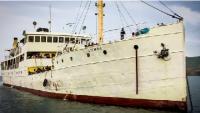 Two years ago, we posted about MV Liemba — the World’s Oldest Passenger/Cargo Steamer at 100. Now 102 years old, MV Liemba continues her passenger and cargo ferry service along the eastern shore of Lake Tanganyika. With luck and funding from the government of Tanganyika, the Liemba may continue to operate for years to come.
Two years ago, we posted about MV Liemba — the World’s Oldest Passenger/Cargo Steamer at 100. Now 102 years old, MV Liemba continues her passenger and cargo ferry service along the eastern shore of Lake Tanganyika. With luck and funding from the government of Tanganyika, the Liemba may continue to operate for years to come.
This August, the Tanzanian government announced that they were budgeting 31 billion Tanzanian shillings (roughly US$14 million) for the repair and refurbishment of three ships, including MV Liemba and the purchase of a new ship during the 2016/17 financial year. Of these funds, 5.6 billion shillings (roughly US$2.6 million) will be dedicated to the Liemba.
Last year, MV Liemba played a critical role in rescuing Burundian refugees who fled across the border to Kagunda, Tanzania. On behalf of the United Nations High Commissioner for Refugees (UNHCR), Liemba made a twice weekly voyage down Lake Tanganyika carrying refugees to the port of Kigoma, where they traveled overland to a refugee camp.
This is not the first time Liemba has carried refugees. In 1997, she was used by the UNHCR to carry more than 75,000 refugees returning home to DR Congo after fleeing war.
The Liemba”s century long history is fascinating. From our previous post:
The 234′ long passenger steamer Graf Goetzen was built in 1913 in Germany, then taken apart, packed in 5,000 crates and shipped to Africa, where the crates traveled by rail and then were carried on the backs of porters to the shores of Lake Tanganyika, where the ship was reassembled. Now named MV Liemba, the passenger ferry continues to operate along the eastern shore of Lake Tanganyika, providing an economic lifeline to scores of villages along the shores of the longest lake in the world.
Prior to World War I German East Africa was a colony which included what are now Burundi, Rwanda, and the mainland part of present Tanzania. The colony was nearly three times the area of present-day Germany. Graf Goetzen was built at the Meyer Werft shipyard in 1913, taken apart, transported and rebuilt as a German passenger ferry for the colony operating on Lake Tanganyika. When the world war broke out, she was converted to an auxiliary cruiser with the addition of four guns — one 10.5 cm, one 8.8 cm, and two 37 mm Hotchkiss revolver guns.
When British and Belgian advanced on the German colony in 1916, the Graf Goetzen was scuttled. She was scuttled, however, with great care. The ship was loaded with sand and all the machinery was covered with a heavy coating of grease. The Germans lost their African colonies during the war, so they did not return to salvage the Graf Goetzen. The British did salvage her in 1924, renaming the ship Liemba. The engines and machinery which had been protected by heavy grease, were recoverable. The ship continued to be powered by a triple expansion steam engine until 1970, when a diesel engine was installed.
If the story of the German ship built, disassembled and then carried by hand to Lake Tanganyika sounds familiar, it may be because the Graf Goetzen was the inspiration for the German ship in C.S. Forester’s novel African Queen. When Hollywood made the movie based on the novel in 1951, the Liemba played a starring role. Humphrey Bogart and Katharine Hepburn also appeared in the film.
Thanks to Alaric Bond for contributing to this post.

-The Luisa!